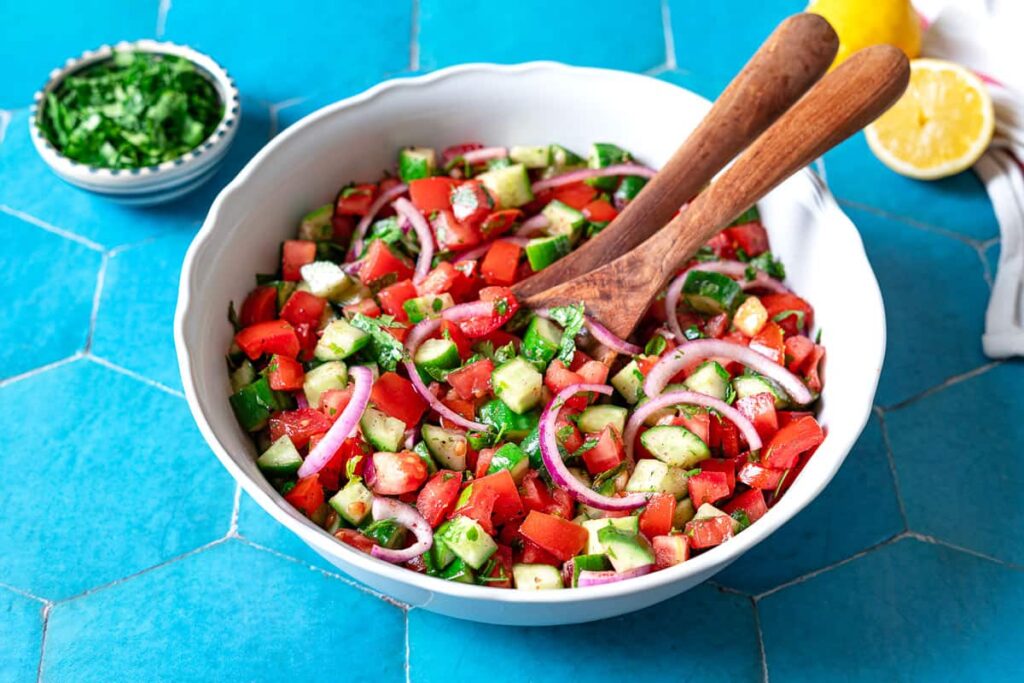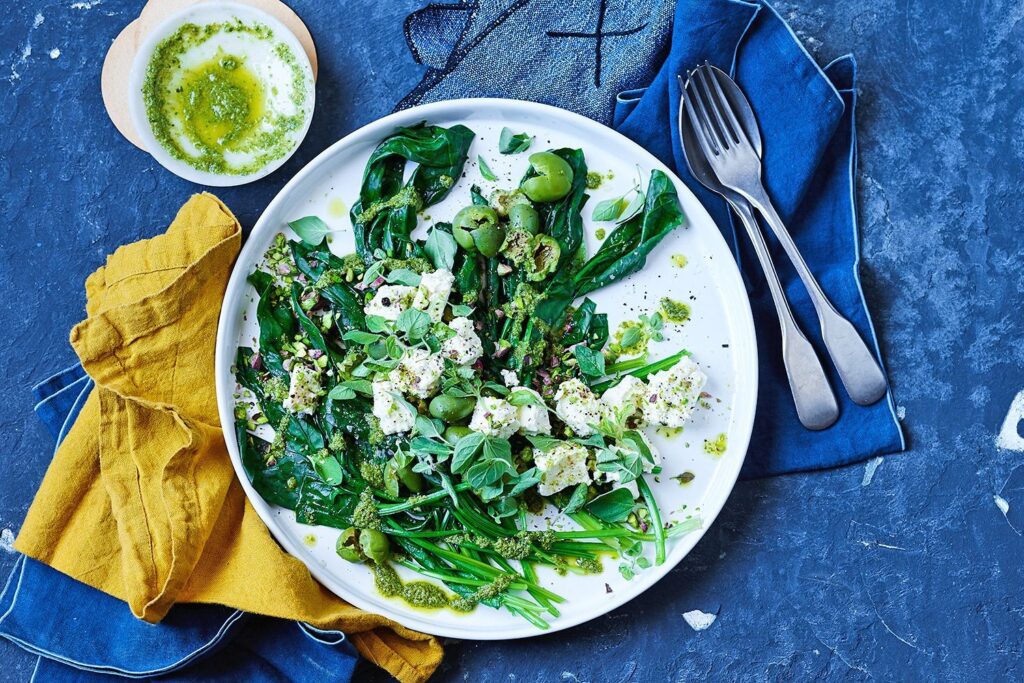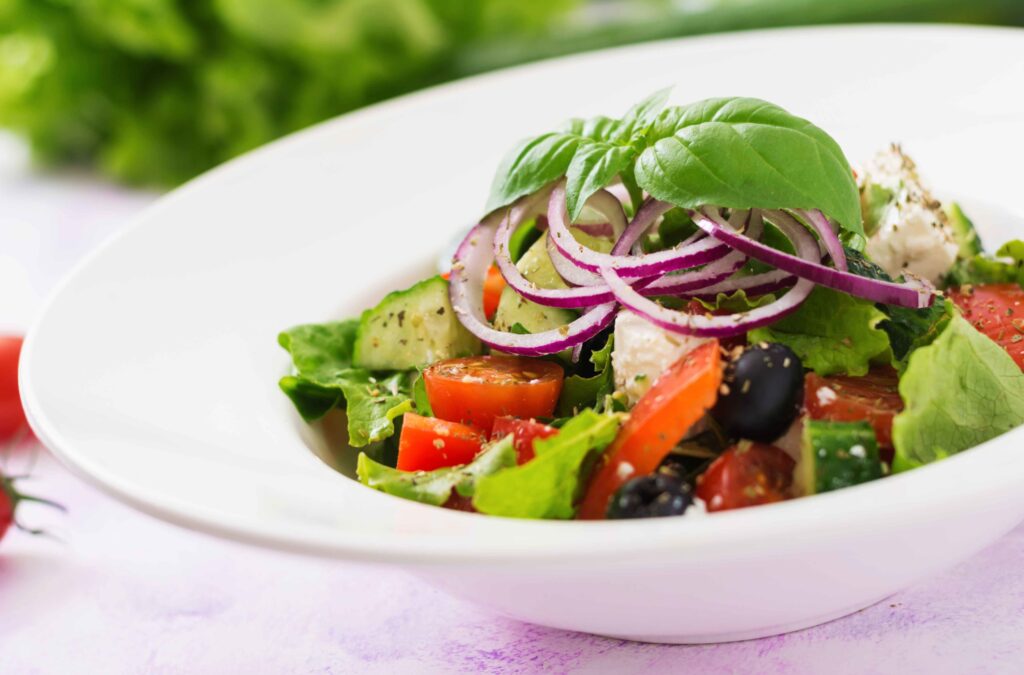Summer is the perfect season to indulge in fresh, vibrant dishes that not only tantalize your taste buds but also nourish your body.
Greek salads are a quintessential summer staple, combining crisp vegetables, tangy cheese, and bold herbs in a harmonious blend that’s both refreshing and satisfying.
In this article, we’ll explore the world of Greek salads and introduce you to several delightful variations that are sure to become your new favorites.

The Classic Greek Salad
What Makes a Greek Salad?
A traditional Greek salad, or “Horiatiki,” is a simple yet flavorful dish.
It typically consists of ripe tomatoes, crunchy cucumbers, green bell peppers, red onions, Kalamata olives, and a generous slab of feta cheese.
The salad is seasoned with dried oregano and drizzled with extra virgin olive oil.
Unlike many other salads, it doesn’t include leafy greens, making it a unique and hearty option.
Ingredients and Preparation
Ingredients:
- Ripe tomatoes
- Cucumbers
- Green bell peppers
- Red onions
- Kalamata olives
- Feta cheese
- Dried oregano
- Extra virgin olive oil
- Red wine vinegar (optional)
- Salt and pepper to taste
Instructions:
- Chop the Veggies: Cut the tomatoes into wedges, slice the cucumbers into half-moons, thinly slice the bell peppers and red onions.
- Assemble the Salad: Combine all the chopped vegetables in a large bowl. Add the Kalamata olives.
- Top with Feta: Place a slab of feta cheese on top of the salad.
- Season and Dress: Sprinkle with dried oregano, drizzle with extra virgin olive oil, and season with salt and pepper. Add a splash of red wine vinegar if desired.
- Serve: Gently toss the salad just before serving to distribute the dressing and enjoy immediately.
Greek Salad Variations
1. Grilled Greek Salad
Adding a Smoky Twist
Grilling the vegetables adds a delicious smoky flavor to the traditional Greek salad.
This variation is perfect for summer BBQs and brings a unique depth to the dish.
Ingredients:
- Tomatoes
- Cucumbers
- Bell peppers
- Red onions
- Kalamata olives
- Feta cheese
- Olive oil
- Dried oregano
- Lemon juice
- Salt and pepper
Instructions:
- Prep the Grill: Preheat the grill to medium-high heat.
- Grill the Veggies: Lightly brush the tomatoes, bell peppers, and red onions with olive oil. Grill until they have nice char marks.
- Assemble the Salad: Cut the grilled vegetables into bite-sized pieces. Combine with cucumbers and Kalamata olives in a large bowl.
- Add Feta and Seasoning: Top with crumbled feta cheese, sprinkle with oregano, drizzle with olive oil and lemon juice, and season with salt and pepper.
- Serve: Toss gently and serve warm or at room temperature.
2. Greek Quinoa Salad
Boosting with Protein
Adding quinoa to your Greek salad not only makes it more filling but also introduces a healthy dose of protein and fiber, perfect for a balanced meal.
Ingredients:
- Quinoa, cooked
- Tomatoes
- Cucumbers
- Red onions
- Bell peppers
- Kalamata olives
- Feta cheese
- Fresh parsley
- Olive oil
- Lemon juice
- Salt and pepper
Instructions:
- Cook the Quinoa: Follow the package instructions to cook the quinoa. Allow it to cool.
- Chop the Veggies: Dice the tomatoes, cucumbers, red onions, and bell peppers.
- Combine Ingredients: In a large bowl, mix the cooked quinoa with the chopped vegetables, Kalamata olives, and crumbled feta cheese.
- Season and Dress: Add chopped fresh parsley, drizzle with olive oil and lemon juice, and season with salt and pepper.
- Serve: Toss to combine and serve chilled or at room temperature.
3. Greek Salad with Chickpeas
Adding Plant-Based Protein
Chickpeas are an excellent addition to Greek salad, providing a boost of plant-based protein and fiber, making it a heartier option for vegetarians and vegans.
Ingredients:
- Tomatoes
- Cucumbers
- Bell peppers
- Red onions
- Kalamata olives
- Chickpeas, drained and rinsed
- Feta cheese (optional for vegans)
- Fresh dill
- Olive oil
- Red wine vinegar
- Salt and pepper
Instructions:
- Prepare the Veggies: Chop the tomatoes, cucumbers, bell peppers, and red onions.
- Combine Ingredients: In a large bowl, mix the chopped vegetables with chickpeas and Kalamata olives.
- Add Feta and Dill: Add crumbled feta cheese (if using) and chopped fresh dill.
- Dress the Salad: Drizzle with olive oil and red wine vinegar, then season with salt and pepper.
- Serve: Toss to coat and serve immediately.

4. Mediterranean Greek Salad Wrap
Perfect for On-the-Go
Transform your Greek salad into a convenient wrap, ideal for lunch or a quick dinner.
This variation combines all the traditional flavors in a portable form.
Ingredients:
- Whole wheat tortillas
- Tomatoes
- Cucumbers
- Bell peppers
- Red onions
- Kalamata olives
- Feta cheese
- Tzatziki sauce
- Fresh spinach or arugula
- Olive oil
- Salt and pepper
Instructions:
- Prepare the Veggies: Dice the tomatoes, cucumbers, bell peppers, and red onions.
- Combine Ingredients: In a bowl, mix the chopped vegetables with Kalamata olives and crumbled feta cheese.
- Season and Dress: Drizzle with olive oil, season with salt and pepper, and mix well.
- Assemble the Wrap: Spread tzatziki sauce on a whole wheat tortilla. Add a handful of fresh spinach or arugula, then spoon the Greek salad mixture onto the wrap.
- Wrap and Serve: Roll up the tortilla, cut in half, and serve.
5. Greek Salad with Orzo
Adding a Mediterranean Touch
Orzo pasta is a fantastic addition to Greek salad, giving it a Mediterranean twist that’s perfect for potlucks or as a side dish for grilled meats.
Ingredients:
- Orzo pasta, cooked and cooled
- Tomatoes
- Cucumbers
- Bell peppers
- Red onions
- Kalamata olives
- Feta cheese
- Fresh basil
- Olive oil
- Lemon zest and juice
- Salt and pepper
Instructions:
- Cook the Orzo: Follow the package instructions to cook the orzo. Let it cool completely.
- Chop the Veggies: Dice the tomatoes, cucumbers, bell peppers, and red onions.
- Combine Ingredients: In a large bowl, mix the cooked orzo with the chopped vegetables, Kalamata olives, and crumbled feta cheese.
- Add Basil and Dress: Add chopped fresh basil, drizzle with olive oil, lemon zest, and juice, and season with salt and pepper.
- Serve: Toss to combine and serve chilled or at room temperature.
Tips for Perfect Greek Salads
Use Fresh Ingredients
The key to a great Greek salad is using the freshest ingredients possible.
Choose ripe tomatoes, crisp cucumbers, and high-quality feta cheese for the best flavor.
Season Generously
Don’t be afraid to season your salad generously with herbs, salt, and pepper.
Fresh herbs like basil, dill, and parsley can elevate the flavors and add a fresh, aromatic touch.
Balance the Flavors
Greek salads are all about balance.
The sweetness of the tomatoes, the crunch of the cucumbers, the brininess of the olives, and the creaminess of the feta all come together to create a harmonious dish.
Adjust the ingredients to suit your taste and ensure every bite is a delight.
Serve Immediately
Greek salads are best enjoyed fresh.
Assemble your salad just before serving to maintain the crispness of the vegetables and the vibrant flavors.
Conclusion
Greek salads are a versatile and delicious way to enjoy the bounty of summer produce.
Whether you stick with the classic version or try one of the exciting variations, you’re sure to enjoy a healthy, flavorful dish that’s perfect for any occasion.
So, gather your ingredients, get creative, and savor the Mediterranean delight of Greek salads.

FAQs
Q1: Can I make Greek salad ahead of time?
A1: It’s best to prepare Greek salad just before serving to keep the vegetables crisp.
If you need to prep ahead, chop the veggies and store them separately, then assemble and dress the salad when ready to eat.
Q2: What can I use instead of feta cheese for a vegan version?
A2: You can use vegan feta cheese or substitute with marinated tofu or avocado for a creamy texture and added flavor.
Q3: How do I store leftover Greek salad?
A3: Store leftover Greek salad in an airtight container in the refrigerator.
It’s best consumed within 1-2 days, as the vegetables may lose their crispness.
Q4: Can I add meat to my Greek salad?
A4: Absolutely! Grilled chicken, shrimp, or even gyro meat can be added to Greek salad for extra protein and a heartier meal.
Q5: What other dressings can I use for Greek salad?
A5: While olive oil and lemon juice are traditional, you can also use a light vinaigrette or a yogurt-based dressing for a creamy twist.
Just be sure to keep the flavors light and fresh to complement the salad ingredients.
